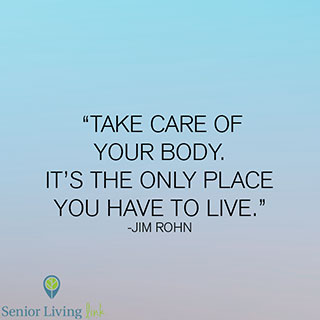
Physical Activity at Any Age
Posted by Donna Mae Scheib on April 20, 2018
Physical Activity at Any Age
According to the Center for Disease Control and Prevention, exercise is one of the most important things you can do for your health at any age. Yet only about 30% of individuals between the ages of 45-64 engage in regular exercise, 25% who are 65-74 years old, and 5% who are 85 or older.

How to squeeze in exercise
Exercising for 30 minutes in the morning at the onset of your day helps you to prioritize “exercise” before you get too busy or begin to put it off. You could try any number of exercise videos, walk the mall corridors or aisles of a neighboring grocery store, or join a gym or exercise facility nearby your house. Sometimes by making it social, “exercise” is just more fun. Find an exercise buddy and take a daily walk, hike, or bike or try a fitness class for seniors.
No need to spend a lot of money
For walking, you only need a pair of comfortable, non-skid shoes. If you are adding weights for strength training exercises, you can use water bottles or soup cans. You can scour the public library for exercise videos and also check out your local park and recreation department, senior center, or Y facility for discounted (free or low-cost) programs for seniors. You might want to use an exercise or yoga mat or a carpeted area for some of the stretching and exercises/activities.
Benefits of exercise
Exercise helps prevent many of the health problems that occur with aging. It helps to keep muscles strong so you can remain as independent as possible in doing various chores, engaging in day-to-day activities, and being mobile without the assistance of a walker, wheelchair, or caregiver. Health benefits also increase: fatigue is reduced, you have more energy, and you can cope better with stress. Your balance improves and you have a more positive outlook on life. Exercise may even help prevent diabetes, heart disease, osteoporosis, and depression─all common conditions as we age.
Types of exercise/activity
A mixture of four types of exercise/activity is recommended for seniors.
Endurance exercise/activity
Helps improve your heart, lungs, and circulatory system. Minimum time suggested: 150 minutes of moderate-intensity weekly. Brisk walking, jogging, dancing, biking, swimming or climbing stairs are some examples. How do you measure intensity? Moderate-intensity is a 5 or 6 on a 10-point scale. Think of sitting down as 0 points and moving as fast as you can (e.g., breaking out a sweat) as a 10. At a moderate intensity level, you will be breathing harder than at rest and your heart will be beating faster. You should be able to carry on a conversation but not sing your favorite song.
Strength exercise/activity
Helps increase muscle strength. Minimum time suggested: 60 minutes 2 days/week that work all major muscle groups: legs, hips, back, abdomen, chest, shoulders, and arms. Try to do 8-12 repetitions of a movement (this is one set) before switching exercises for another muscle group. You can work up to 2-3 sets per movement. These exercises involve lifting weights or using resistance bands as well as doing exercises that use your body weight for resistance like push ups and sit ups. Heavy gardening (digging, shoveling) and yoga are two activities that also build muscle strength.
Balance exercise/activity
Helps you to prevent falls, one of the highest health risks for older adults. Minimum time suggested: 5-10 minutes, 4 times a week. You can simply march in place (lifting one knee as high as possible at a time) or incorporate any of the Tai Chi movements. Other popular exercises include balancing on one leg while the other leg is bent at the knee; standing on your tip-toes while extending your arms outward; walking on your heels and then your toes. You can do any of these exercises while pressing against a wall, chair or counter to prevent falling. Another recommended exercise is to sit in a chair (without arms) and cross your arms across your shoulders; then stand up and sit down, keeping your head up and trying not to look down or lean forward as you stand up.
Stretching exercise/activities
Help you to have more movement in your joints and help improve posture. These exercises also help to release muscle tension and soreness and reduce the risk of injury while increasing circulation, muscle control, and overall coordination/flexibility. When stretching, it is important to take a deep breath and slowly exhale as you stretch. Minimum time suggested: 10-15 minutes, 2 times a week and, if possible, 5 minutes on all the days after you do the endurance and strength exercises.
Try these different stretches:
- neck stretch (bring your chin toward your chest and turn your head side to side; hold each position for 15 seconds)
- shoulder and upper arm stretch (hold a towel in one hand over your head and let it drape down behind your head and back; grab the other end of the towel with your other hand and gently pull down until you feel a stretch)
- chest stretch (extend both arms to the side with palms facing forward; reach back with your hands until you feel a stretch across your chest and front of your arms)
- ankle stretch (sit in a chair and slowly move your foot up and down and side to side; repeat on the other foot)
- hamstring stretch (lie on your back and extend one leg perpendicular to your body; grasping around the back of your thigh, slowly pull the leg towards you while keeping the other leg and hip on the ground)
- quadriceps stretch (lie on your side and bend your knee, bringing your foot behind you; pull your foot towards your body until you feel a stretch)
- hip stretch (lie on your back, bringing one knee out to the side of your body; rest your foot against your opposite leg and gently push down on the bent knee until you feel a stretch)
- lower back stretch (lie on your back with your knees bent and feet together; keep your feet flat on the floor)
In Conclusion
It is recommended that before beginning an exercise routine that you check with your doctor and talk about the suggested exercises/activities and get the okay before proceeding. And remember, anyone at any age can benefit from exercise. Now is the time to embrace more activity and better health in your life!
Want more resources? Learn More >>
Want to stay updated with our blog posts and other resources? Sign up for monthly newsletter >>







